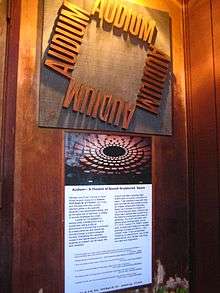Audium (theater)
Audium is a sound art event that has been presented weekly in San Francisco since 1967. Audium is a creation of composer Stan Shaff that is performed on original equipment designed by Doug McEachern. It is played in a completely dark theater designed to heighten the spatial effects of sound and for "choreographing sound in space." [1] Compositions are developed from acoustic and electronic instruments and from sounds of the natural world used as metaphors. Works are "sculpted" in space through 176 speakers.

Early development
The concepts gradually refined in Audium began with Shaff and McEachern's experimental electronic music performances in the late 1950s and early 1960s. In 1959, Stan Shaff met fellow musician and teacher Douglas McEachern, whose background in electronics enabled him to develop original equipment systems for live, spatial performances.[1] Prior to Audium, Shaff and McEachern worked with Anna Halprin's Dancer's Workshop and Shaff worked with Seymour Locks, an artist and the originator of the overhead projected light show later used widely at rock concerts in the 1960s. Shaff was also associated with the Tape Music Center in San Francisco. Early presentations were done at University of California Extension (1960), San Francisco State College (1962) and San Francisco Museum of Art (1963, 1964).[2] These early performances were done with "portable systems" that had about 8 to 16 speakers.[2][3]
The first theater
To proceed with experimenting and with exploring these ideas, McEachern and Shaff, in 1965, leased a hall at 309 4th Avenue in San Francisco and began adapting it to become the first Audium theater. It initially was outfitted with 44 speakers, and on May 26, 1967 the first public performance was held. By 1968 the number of speakers had increased to 61. Weekly performances were presented until October 1970. The theater had to close when the lease ended and the building was sold.[3]
The second theater

In 1972 Shaff received a grant from National Endowment for the Arts. A storefront, formerly a bakery, in downtown San Francisco was purchased and subsequently converted to a theater.[2] The first public presentation was October 31, 1975 and weekend shows have continued since then. Beginning with 136 speakers, the phenomenon has gradually and unrelentingly grown and evolved. It now has over 176 speakers,[4] and Stan Shaff presents his 9th opus, AUDIUM 9, every Friday and Saturday, opening at 8 PM.[5]
Attendance & acclaim
The performances have been described as "surreal" and one piece as a "musique concrete of beach sounds, faintly overheard conversations and outdated Moog synthesizer whirls and chortles."[6] Another author said that Audium harnesses "the primal essence of sound" and that after a performance "you'll emerge uncertain, excitable, outside of yourself." [7] According to Shaff, Audium is periodically visited by members of Walt Disney Imagineering, the R&D arm of the Walt Disney Company,[6] engineers from Dolby Laboratories, sound engineers from the film industry, the Audio Engineering Society, and composers from international universities.[8] Shaff has done very little advertising,[9] but after ongoing programs since 1967, Audium now attracts weekly listeners from around the world.[8]
References
- "Biography". Other Minds website. Archived from the original on 7 February 2008. Retrieved 5 Mar 2009.
- Alfred Frankenstein (Jan 1977). "Space-Sound Continuum in Total Darkness". History of Experimental Music in Northern California. Archived from the original on 18 October 2007. Retrieved 5 Mar 2009.
- "History". Audium website. Archived from the original on 17 September 2008. Retrieved 11 Mar 2009.
- "Audium: See With Your Ears". PingMag. 25 Aug 2008. Archived from the original on 26 February 2009. Retrieved 11 Mar 2009.
- "Location". Audium website. Archived from the original on 1 February 2009. Retrieved 11 Mar 2009.
- Sullivan, James (August 30, 2001). "Surreal sculpture for the ear, Audium celebrates a quarter-century". San Francisco Chronicle. Retrieved 10 Mar 2009.
- Richard Fitzpatrick, "A 'sound' experience," in Western Edition Vol 2, Number 9, August 1995
- "Audium's visitors". Audium website. Archived from the original on 19 September 2008. Retrieved 5 Aug 2009.
- Gareth Loy (1985). "About Audium – A Conversation With Stanley Shaff". Computer Music Journal. Archived from the original on 24 June 2017. Retrieved 9 Mar 2009.